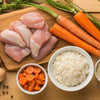What Is the Best Dog Food for a Labrador Puppy? A Comprehensive Guide for Pet Parents
- Houndsy
Table of Contents
- Introduction
- Understanding Labrador Puppies' Nutritional Needs
- Types of Dog Food: Kibble, Wet Food, or Raw Diets?
- Portion Control: How Much Should You Feed?
- Feeding Schedule: Establishing Routine
- The Houndsy Difference: Elevating the Feeding Experience
- Common Concerns: Addressing Questions About Puppy Nutrition
- Conclusion
- FAQ
Introduction
Picture this: you’ve just brought home your energetic Labrador puppy, full of life and eager to explore. As you fill your home with toys and training tools, a pressing question looms: what is the best dog food for a Labrador puppy? For many new pet owners, this question marks the beginning of a journey filled with choices, research, and, at times, a bit of anxiety. According to the American Kennel Club, Labrador Retrievers are among the most popular dog breeds in the world, noted for their affectionate nature and versatility. Given their popularity, knowing how to properly feed your Lab during its formative weeks and months is crucial for their health and development.
The significance of choosing the right food can't be understated. Inadequate nutrition during their growth phases can lead to long-term health issues, including obesity, bone deformation, and various nutritional deficiencies. In this blog post, we’ll delve into the critical aspects of Labrador puppy nutrition, exploring types of dog food, essential nutrients, portion control, feeding schedules, and how our innovative Houndsy Kibble Dispenser can help streamline your feeding routine and elevate your pet care experience. By the end of this article, not only will you have a clearer understanding of what to feed your Lab puppy, but you’ll also be equipped with practical tips to facilitate a healthy feeding routine.
So, let’s embark on this journey to discover not just what food to feed, but how to make feeding a delightful experience for both you and your new furry friend!
Understanding Labrador Puppies' Nutritional Needs
Labrador puppies are big bundles of joy, but they also demand specific nutritional attention. Their growth rate and energy levels dictate that they need adequate proportions of protein, fats, carbohydrates, vitamins, and minerals.
1. Nutritional Profiles for Labrador Puppies
When considering what is the best dog food for a Labrador puppy, one of the first aspects to evaluate is the nutritional profile. Generally, puppy food for Labs should include:
- Protein: 28-30% from quality animal sources (e.g., chicken, lamb, or fish) to support muscular development.
- Fat: A healthy fat content should be around 15-20%, essential for energy and growth.
- Carbohydrates: Around 20-22% from sources like grains or legumes to provide essential energy.
- Vitamins and minerals: Supplements like calcium, phosphorus, and DHA to promote bone health and cognitive function.
2. Essential Ingredients
While many brands offer specialized formulas for large breed puppies, focusing on high-quality ingredients is paramount. Cabin lists ingredients to avoid, like fillers or artificial additives. Thus, ingredients such as whole meats, wholesome grains, and vegetables should be prioritized.
3. Avoiding Nutritional Pitfalls
Not all dog food is created equal. Opting for foods that adhere to the AAFCO (Association of American Feed Control Officials) standards ensures that the nutritional content meets the appropriate levels for growth. Additionally, avoid grain-free diets unless your pet has specific grain allergies, as they've been linked to health concerns in various studies.
Types of Dog Food: Kibble, Wet Food, or Raw Diets?
As pet parents, we often find ourselves standing in the pet food aisle, overwhelmed by the options. Let's break down each type to determine what is best for our Labrador puppies.
1. Kibble (Dry Dog Food)
Kibble is the most common choice for many puppy parents. Here’s why:
- Convenience: Kibble is easy to store and can be pre-measured, making it quick to serve.
- Cost-Effective: It tends to be less expensive than wet food and provides comprehensive nutrition.
- Dental Benefits: The crunchy texture helps clean teeth and reduce plaque buildup.
While kibble might seem like the clear frontrunner, it’s vital to choose high-quality brands that prioritize wholesome ingredients. This is where our Houndsy Kibble Dispenser becomes a game-changer. It provides perfect portion control at standing height—eliminating the strain of bending down to serve your pup, while its elegant design complements your home's aesthetic. Explore how the Houndsy Kibble Dispenser can transform feeding time for you and your puppy here.
2. Wet Food
Wet food is often touted for its palatability and high moisture content. Consider these aspects:
- Hydration: The moisture can aid in keeping your puppy hydrated, especially important in hot weather.
- Taste Appeal: Many puppies find wet food irresistible, making it useful for picky eaters.
However, keep in mind that wet food can be more costly and might require refrigeration after opening. It also has a shorter shelf life compared to kibble. For those considering wet food, a combination of both kibble and wet food can be a balanced approach.
3. Raw Diet
Raw diets are an emerging trend, but they come with their own set of challenges:
- Balanced Nutrition: Preparing a raw diet requires knowledge to ensure a well-rounded nutrient profile.
- Food Safety: Puppies have immature immune systems, making them more susceptible to pathogens often found in raw meat.
Consulting a veterinarian before opting for a raw diet is essential, as they can provide guidelines to ensure your puppy’s safety and well-being.
Portion Control: How Much Should You Feed?
Feeding a Labrador puppy also involves precise portion control. Overfeeding can lead to obesity, while underfeeding may impede healthy growth. Here are some general guidelines:
1. Feeding Charts
Most puppy food brands provide feeding guides based on the puppy’s weight and age. A common recommendation is:
- 8 weeks to 3 months: Four meals a day
- 3 to 6 months: Three meals a day
- 6 months to adulthood (around 12 months): Two meals a day
Always remember, these guidelines are rough estimates. Observing your puppy's body condition and adjusting as necessary is critical.
2. Monitoring Body Condition
Your puppy should have a discernible waist with a healthy body condition score. If you notice any signs of excessive weight gain or loss, consider adjusting your puppy’s portion sizes.
Feeding Schedule: Establishing Routine
Having a consistent feeding schedule is vital for your Labrador puppy. This routine not only helps in establishing good habits but also aids in digestion.
1. Meal Timing
Feeding your puppy at the same time each day promotes predictability for both you and your puppy. Here’s a suggested structure:
- Morning: Breakfast
- Midday: Lunch (especially for puppies 3 months and younger)
- Evening: Dinner
2. Snack Time
Tactfully incorporating treats and snacks can provide extra bonding moments. However, make sure these do not exceed 10% of their daily caloric intake to prevent unintentional weight gain.
The Houndsy Difference: Elevating the Feeding Experience
At Houndsy, our mission is to simplify and elevate the pet feeding experience. Feeding your puppy should be a joyful and engaging routine rather than a chore filled with mess and hassle. Introducing our Houndsy Kibble Dispenser—a product that seamlessly integrates design excellence with functionality.
1. Ergonomic Design
The dispenser's crank mechanism allows portion control at standing height, preventing unnecessary strain on your back. This innovative approach means less bending and more enjoyment for both you and your pup.
2. Large Capacity and Safety Features
With a storage capacity of 25-30 lbs and a BPA-free liner, we ensure your puppy’s food remains fresh and safe. Plus, the auto-locking mechanism prevents accidental dispensing—perfect for curious puppies or toddlers.
3. Stylish Addition to Your Home
Who says pet products can't be stylish? Our Houndsy Kibble Dispenser boasts a sleek mid-century modern design, ensuring it complements contemporary home decor while enhancing your feeding routine.
Explore the perfect blend of form and function with the Houndsy Kibble Dispenser here.
Common Concerns: Addressing Questions About Puppy Nutrition
Should I Feed My Labrador Puppy Table Scraps?
While it can be tempting to share your food with your pup, it’s crucial to maintain a well-rounded diet primarily made up of puppy food. Foods like chocolate, onions, and grapes can be harmful to dogs, so adhere strictly to recommended dog foods.
When Should I Switch to Adult Dog Food?
After your Labrador reaches its first birthday, it’s time to transition from puppy food to adult formulations. The growth rate slows significantly after this point, and adult food helps maintain a healthy weight.
How Can I Tell if My Puppy has a Food Allergy?
Signs of allergies may include itchy skin, gastrointestinal issues, or unusual behavior. If you suspect a food allergy, consult your veterinarian, who may recommend eliminating certain proteins to identify the trigger.
Is It Normal for My Labrador to Eat Quickly?
Labradors are known for their appetite, but gulping food too quickly can cause digestive issues. Feeding using a slow feeder, a bowl designed to promote slower eating, can be beneficial.
Conclusion
Choosing the best dog food for your Labrador puppy can seem like a daunting task, but with the right information and resources, it can be a rewarding endeavor. Focusing on high-quality ingredients, understanding portion sizes, and establishing a reliable feeding routine are keys to raising a healthy pup. We at Houndsy are proud to offer products that not only streamline this process but also elevate the entire experience, ensuring that feeding and caring for your furry family member is a part of your daily routine that brings joy and satisfaction.
As you embark on this exciting journey with your new Labrador puppy, remember: proper nutrition lays the foundation for a happy, healthy, and playful life. If you want to simplify your routine while elevating your feeding experience, consider our Houndsy Kibble Dispenser. Check it out here and make feeding your Labrador puppy a delightful part of your day.
FAQ
1. What should I look for on a dog food label?
Look for key ingredients like real meats as the primary source of protein, whole grains, and a certification from AAFCO. Avoid fillers and artificial additives.
2. Can I mix kibble and wet food for my Labrador puppy?
Yes, mixing kibble with wet food can enhance taste and add moisture, but ensure it doesn’t exceed your puppy's caloric needs.
3. How can I help my Labrador puppy maintain a healthy weight?
Regular exercise, proper portion sizing, and quality dog food will help maintain your puppy’s weight. Monitoring weight and body condition is essential as they grow.
4. Are certain dog food brands better than others?
Yes, well-known brands with a good reputation for quality ingredients and nutritional standards are generally better. Your veterinarian can help recommend brands suitable for your puppy.
5. When is the best time to transition from puppy food to adult food?
Typically, you can start transitioning when your Labrador reaches one year old. Consult your veterinarian for tailored advice based on your puppy’s growth rate.
With this comprehensive guide, we hope that choosing the best dog food for your Labrador puppy becomes a clear and positive experience. Remember, happy feeding leads to a happy dog!












